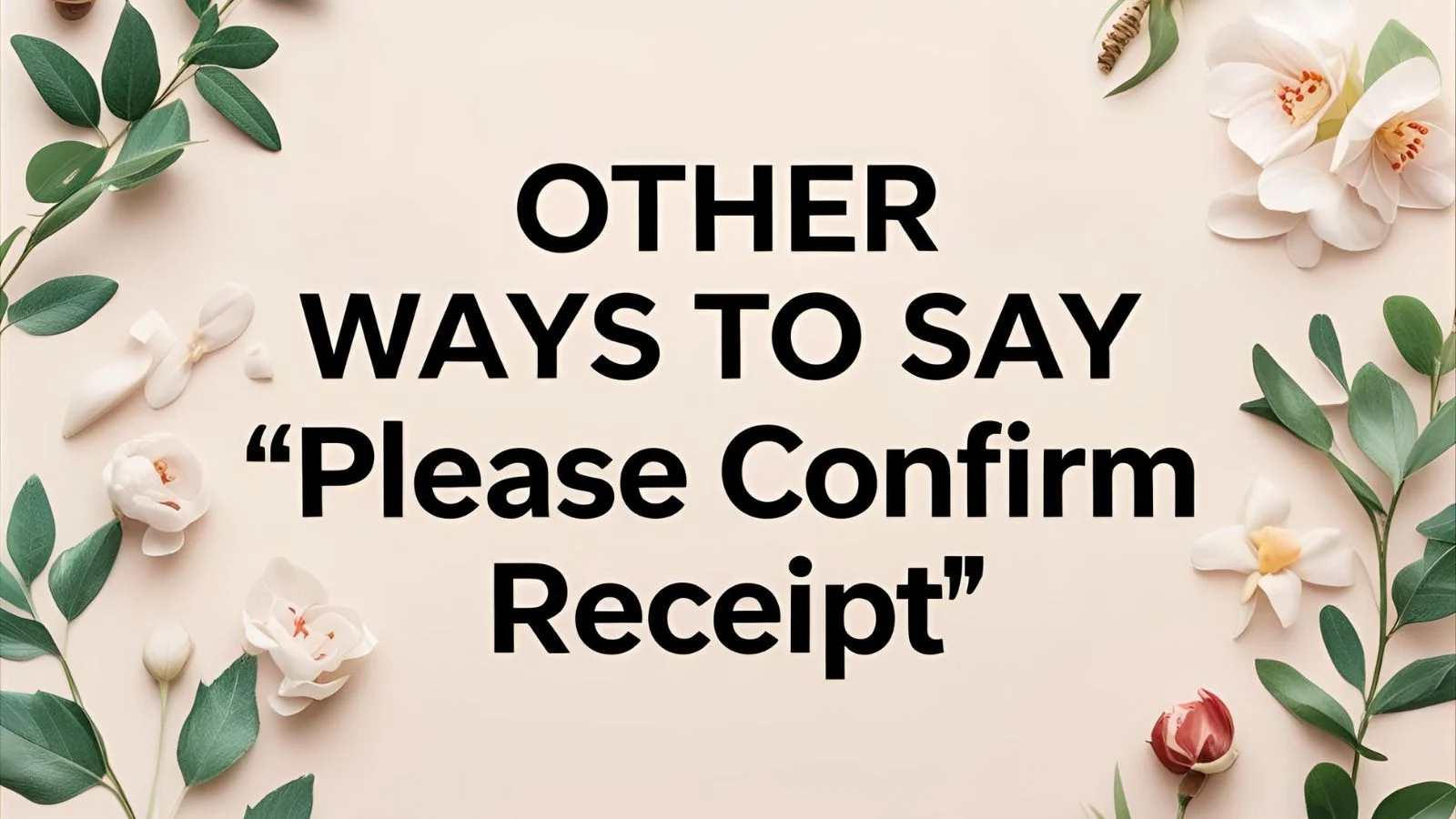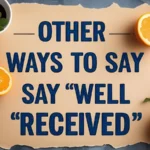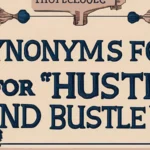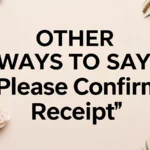In professional communication, it is important to acknowledge received messages, emails, or documents. The phrase “please confirm receipt” is commonly used, but it can sometimes feel repetitive or overly formal. Finding alternative ways to phrase this request can make your communication feel more natural and engaging while still maintaining professionalism. Other Ways to Say “Please Confirm Receipt”.
Using varied expressions can improve your writing style and tone. Whether you’re emailing a colleague, a manager, or a client, a well-crafted message helps ensure clarity and prompt response. Depending on the situation, you might want a more formal, casual, or polite alternative. Some alternatives can be direct, while others add warmth or friendliness.
This article explores different ways to say “please confirm receipt” while keeping your emails clear and professional. We will cover a range of alternatives, from simple direct requests to more polite and engaging options.
Kindly Confirm That You Have Received This
This phrase keeps the request polite while ensuring the recipient acknowledges the email or document. It is suitable for professional emails where confirmation is necessary.
Example: “Dear [Name], I wanted to ensure that my previous email reached you. Kindly confirm that you have received this at your earliest convenience.”
This alternative maintains a professional tone and is effective when communicating with clients, vendors, or managers. Adding “at your earliest convenience” makes it sound polite while emphasizing the importance of a response.
Using this phrase in formal business settings ensures clarity without being too demanding. It keeps communication smooth and ensures accountability when sharing important documents or information. If used in customer service, it reassures the sender that the recipient has acknowledged the request.
Whether you are requesting confirmation for an invoice, an agreement, or a report, this phrase works well across industries. It is a simple yet effective alternative to the standard “please confirm receipt” phrase.
Read More: Other Ways to Say “You Guys”
Please Acknowledge Receipt of This Email
This phrase serves as a direct yet professional alternative. It ensures the recipient confirms receiving an email while keeping the tone neutral.
Example: “Dear [Name], I recently sent an important document regarding our project. Please acknowledge receipt of this email so I can be sure it has reached you.”
The phrase works well in professional settings where clarity is crucial. It is frequently used in workplaces that require formal documentation and confirmation, such as legal, finance, or administrative roles.
By requesting an acknowledgment, you prompt the recipient to confirm without sounding too demanding. This phrasing is especially useful in scenarios where timely responses are necessary. It also reduces misunderstandings, ensuring that important communications do not go unnoticed.
If you require proof of receipt for legal or contractual purposes, this phrase is highly effective. It adds a level of formality while keeping the request clear and professional.
Could You Confirm That You Received This?
This phrase is slightly less formal but still professional. It makes the request sound conversational, making it ideal for workplace communication.
Example: “Hi [Name], I sent over the requested report earlier today. Could you confirm that you received this?”
This alternative works well in internal company communication, where a friendly yet professional tone is preferred. It invites a response in a way that does not feel too authoritative or formal. The question format encourages engagement, prompting the recipient to reply promptly.
By using “Could you,” the request feels softer and more polite. It creates a balance between formality and friendliness, making it useful for messages to colleagues, managers, or external partners.
This phrase is a great choice when you need confirmation without making the recipient feel pressured. It also works well in follow-ups when the recipient has not yet responded to the original email.
Let Me Know If You Have Received This
This phrase makes the request feel more casual while still being clear and professional. It is suitable for both formal and informal emails.
Example: “Hello [Name], I sent over the updated files. Let me know if you have received this.”
This phrase is great for friendly workplace communication, allowing for a relaxed but still professional interaction. It works well when sending attachments, important updates, or follow-up emails.
The wording feels warm and approachable, making it a good choice when communicating with team members or colleagues. It also works well for customer interactions where a friendly and customer-focused approach is required.
Since it is phrased as a request rather than a demand, it encourages responses while keeping the tone light and engaging. This alternative is useful for casual business settings where communication flows naturally without strict formality.
Can You Please Confirm That You Received My Email?
This phrase adds an extra layer of politeness by including “please,” making it suitable for professional and business emails. It is direct but does not sound too demanding.
Example: “Hi [Name], I wanted to make sure my email reached you. Can you please confirm that you received it?”
This alternative is effective when following up on important documents or emails. It is particularly useful when dealing with clients, colleagues, or external partners, as it maintains a balance between professionalism and friendliness.
By phrasing it as a question, you invite the recipient to respond without making them feel pressured. This phrase is also useful when you suspect an email may have gone to spam or if a response is needed urgently.
Using a clear and polite request like this ensures smoother communication and avoids potential misunderstandings. It keeps the conversation open while maintaining a respectful and professional tone.
Just Checking to See If You Received My Email
This phrase has a casual, friendly tone that is ideal for informal workplace communication. It makes the request feel natural and non-demanding.
Example: “Hey [Name], just checking to see if you received my email. Let me know when you get a chance!”
This alternative works well in casual business environments where a relaxed communication style is encouraged. It is useful when following up with team members, close colleagues, or long-term clients.
By keeping it light, you avoid making the recipient feel like they are being rushed. Instead, it serves as a gentle reminder. The friendly tone also makes it effective for internal company emails where formality is not required.
If you are sending a follow-up to someone you have a good rapport with, this phrase helps maintain a comfortable and open communication style. It encourages a response without putting too much pressure on the recipient.
I Would Appreciate It If You Could Confirm Receipt
This phrase adds a touch of formality and gratitude, making it suitable for professional and respectful communication.
Example: “Dear [Name], I sent the contract earlier today. I would appreciate it if you could confirm receipt when you have a moment.”
This alternative is ideal for situations where you need to sound polite and professional. It works well for emails to clients, supervisors, or business partners.
By using “I would appreciate it,” you show gratitude while making the request, which encourages a positive response. This phrase is particularly effective in corporate settings where courtesy is highly valued.
Using this phrase helps maintain professionalism while ensuring clarity. It is best suited for formal emails and situations where you need confirmation without appearing too forceful.
Could You Let Me Know If You Received This?
This phrase is direct but friendly, making it great for professional and semi-formal communication.
Example: “Hi [Name], I sent over the updated report earlier today. Could you let me know if you received this?”
This alternative works well in both formal and informal settings. It is useful for following up on emails, reports, or important messages where a response is needed.
By using “Could you,” the request feels more polite and less demanding. The phrase is also open-ended, making it easier for the recipient to reply at their convenience.
It is particularly useful for business correspondence, where clarity and professionalism are essential. The phrase encourages engagement while keeping the email warm and approachable.
Please Confirm Once You Have Received This
This phrase adds an extra layer of politeness while ensuring the recipient acknowledges your message.
Example: “Hello [Name], I have sent the requested files. Please confirm once you have received this so we can proceed with the next steps.”
This alternative is useful when you need confirmation before taking further action. It is commonly used in corporate environments, project management, and client communications.
By specifying “once you have received this,” you allow the recipient some flexibility in responding. The phrase maintains a professional and courteous tone while ensuring clear communication.
This phrase is effective for formal emails where a direct yet polite approach is needed. It sets a clear expectation for a response without making the recipient feel rushed.
A Quick Reply to Confirm Receipt Would Be Appreciated
This phrase makes the request sound warm and appreciative, encouraging a positive response.
Example: “Hi [Name], I sent over the invoice a few minutes ago. A quick reply to confirm receipt would be appreciated.”
This alternative is useful when you need a prompt response but do not want to sound too pushy. It is particularly effective for emails regarding important documents, invoices, or time-sensitive matters.
The phrase “would be appreciated” adds politeness and gratitude, making the request sound more natural. It is suitable for both formal and informal business emails.
By keeping the request short and to the point, you make it easy for the recipient to reply quickly. This phrase ensures clarity while maintaining a professional yet friendly tone.
Let Me Know If This Reached You Safely
This phrase adds a touch of warmth and concern, making it ideal for friendly and professional emails.
Example: “Hey [Name], I sent the presentation earlier today. Let me know if this reached you safely!”
This alternative is particularly useful when sending important files, documents, or sensitive information. It reassures the recipient that you are ensuring smooth communication.
The phrase “reached you safely” makes it sound more personal and caring. It works well in workplaces where a friendly and engaging tone is encouraged.
This phrase is ideal for follow-ups in informal business settings where you have an established relationship with the recipient. It keeps the email light and friendly while ensuring a response.
Can You Confirm That You Have Received the Attached File?
This phrase is useful when you need to confirm that an attachment has been successfully received.
Example: “Dear [Name], I have attached the signed agreement as requested. Can you confirm that you have received the attached file?”
This alternative works well in professional environments where documents, reports, or contracts are frequently exchanged. It ensures clarity while keeping the request formal and polite.
By specifying “attached file,” you make it clear that the confirmation is related to the document. This phrase is ideal for emails involving legal, financial, or corporate communications.
Using a direct but courteous request like this helps maintain professionalism while ensuring important documents do not get lost in transit.
Conclusion
Using alternative ways to say “Please confirm receipt” enhances your communication while maintaining professionalism. Whether you need a formal, casual, or polite approach, choosing the right phrase ensures clarity and encourages prompt responses.
Different situations require different tones. A formal phrase like “Please acknowledge receipt of this email” is perfect for business settings, while a friendly phrase like “Just checking to see if you received my email” works well for casual conversations.
By varying your language, you keep your emails engaging while ensuring effective communication. Next time you need confirmation, try one of these alternatives to make your messages sound more professional and natural.










